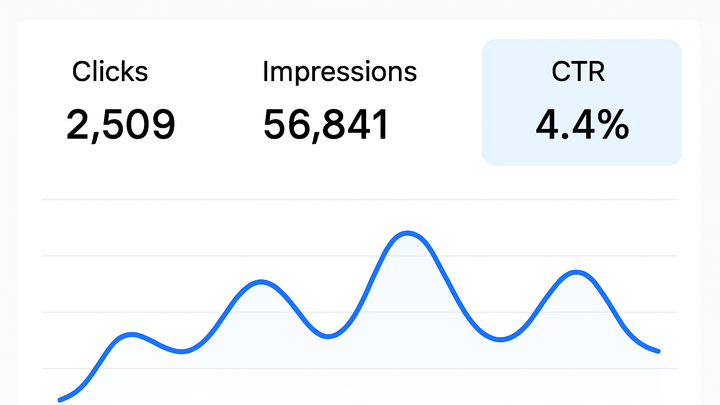Published on 2025-06-22T02:15:24Z
What is Click-Through Rate (CTR)? Examples for CTR.
Click-Through Rate (CTR) is a key performance indicator in digital analytics that measures the ratio of user clicks on a link, ad, or call-to-action to the number of times it was displayed (impressions). Expressed as a percentage, CTR = (Clicks / Impressions) × 100. A higher CTR indicates stronger engagement and relevance, helping marketers and analysts evaluate the effectiveness of email campaigns, display ads, search ads, and on-site CTAs. Tools like PlainSignal and Google Analytics 4 (GA4) provide native CTR reporting to guide optimization of marketing spend, user experience, and content strategy. Monitoring and improving CTR can directly impact ROI, quality scores, and overall campaign success.
Click-through rate (ctr)
Percentage of clicks to impressions, showing how engaging or effective a link, ad, or CTA is.
Understanding Click-Through Rate
This section dives into the definition, calculation, and core components of CTR. Learn how it’s derived and why each element matters.
-
Ctr formula
CTR is calculated as (Clicks / Impressions) × 100, yielding a percentage that reflects user engagement with links or ads.
-
Clicks
The number of times users have clicked on a specific link, ad, or call-to-action.
-
Impressions
The number of times the link, ad, or call-to-action has been displayed or viewed by users.
-
-
Interpreting ctr
A higher CTR generally indicates that content resonates well with the audience, while a low CTR may signal issues with relevance, messaging, or placement.
Why CTR Matters
CTR is a critical metric for assessing campaign performance, user engagement, and return on investment across marketing channels.
-
Campaign performance
Helps determine which ads, email subject lines, or CTAs drive the most interest and clicks from your audience.
-
Cost efficiency
A higher CTR can lower cost per click (CPC) in paid advertising and improve quality scores in platforms like Google Ads.
-
Ux and content optimization
On websites, tracking CTR for buttons and links guides designers toward more engaging layouts and calls-to-action.
Examples in Analytics Tools
Different analytics platforms calculate and report CTR with slight variations. Here’s how CTR appears in PlainSignal and GA4.
-
PlainSignal (cookie-free simple analytics)
PlainSignal automatically tracks impressions and clicks on links and buttons without cookies, emphasizing user privacy.
-
Implementation example
<link rel="preconnect" href="//eu.plainsignal.com/" crossorigin /> <script defer data-do="yourwebsitedomain.com" data-id="0GQV1xmtzQQ" data-api="//eu.plainsignal.com" src="//cdn.plainsignal.com/plainsignal-min.js"></script>
-
-
Google analytics 4 (GA4)
GA4 calculates CTR for search ads and on-site events when you configure click events and impression tracking in your property settings.
Best Practices to Improve CTR
Improving CTR involves refining messaging, design, and targeting. These strategies can drive more effective clicks and higher engagement.
-
Compelling headlines and ctas
Use clear, benefit-driven language and value propositions to entice users to click.
-
A/b testing
Test different headlines, button colors, and placements to identify which variations yield the highest CTR.
-
Audience segmentation
Tailor ads and content to specific user segments to increase relevance and improve click rates.
